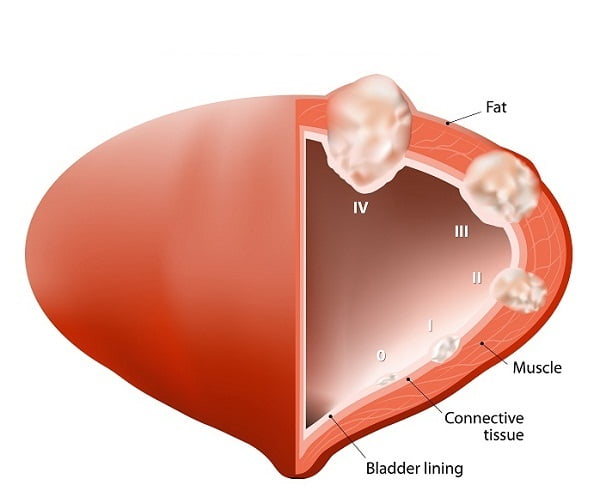
What is bladder cancer?
Bladder is a hollow, pouch like organ in the lower abdomen which stores urine for some time before it leaves the body. Bladder cancer is a type of cancer in which the bladder cells experiences an abnormal cell multiplication and growth.
This cancer has the ability to spread or metastasize to other parts of the body such as lungs, liver, bones, etc.
According to some reports, bladder cancer is one of the most common types of cancer which affects approximately 68,000 adults in the United States every year. This type of cancer is more commonly observed in adult men compared to women.
The bladder consists of three layers. The cancer starts from the innermost layer known as mucosa. It can be either confined to specific location or can even invade other parts of the bladder. The bladder cancer can appear in a variety of forms such as papillary form, nodule form or an irregular solid growth.
What are the types of bladder cancer?
Bladder cancer is classified into different categories based on the appearance of its cells under the microscope (histological type). Some common types of bladder cancer are as follows:
Urothelial carcinoma
Urothelial carcinoma is also referred as transitional cell carcinoma. It is the most common form of bladder cancer in the United States.
Urothelial carcinoma occurs in the inner lining cell of the bladder known as urothelial cells. These cells expand when the urine has reached its maximum capacity in the bladder and shrinks when urine leaves the bladder.
Squamous cell carcinoma
Squamous cell carcinoma is a type of cancer which causes chronic irritation in the bladder. It is very rare in the United States but is very common in those parts of the world where a certain parasitic infection like schistosomiasis is prevalent.
Adenocarcinoma
There are certain types of cells which make up mucus-secreting glands in the bladder. Cancer in such type of cells is known as adenocarcinoma. It is a rare form of bladder cancer found in the United States.
What is the cause of bladder cancer?
The exact cause of bladder cancer is still unknown. Bladder cancer can develop due to any change in the DNA. Such changes are referred to as mutations. Mutation in any gene may turn on certain genes or turn off certain types of genes which increase the chances of a person suffering from bladder cancer.
There are two different types of mutations which cause bladder cancer. They are:
Acquired gene mutation
Acquired gene mutation is related to bladder cancer that develops during a person’s life and not been inherited before birth. Some of these acquired gene mutations occur due to the exposure to any cancer-causing chemicals or radiation. For example, chemicals in tobacco smoke are absorbed in the blood, filtered by the kidneys, and excreted through urine, where they can affect bladder cells.
The gene mutation that causes bladder cancer is not the same in every person. Changes in certain genes, like RB1 or TP53 tumor suppressor genes and the RAS and FGFR oncogenes, play a major role in the development of certain bladder cancers.
Inherited gene mutation
Some people inherit gene mutations from their family which increases the risk of bladder cancer. Bladder cancer, however, does not run in families. Some people inherit a reduced ability to break down certain cancer-causing chemicals.
What are the risk factors for bladder cancer? Are you at risk of bladder cancer?
There are several types of risk factors which increase the chances of developing bladder cancer. Some of them are as follows:
Tobacco Smoke
Smoking is the most common risk factor for bladder cancer. Smokers are three times more likely to develop bladder cancer than non-smokers. Smoking cigarettes, cigars, etc increases the risk of bladder cancer because these harmful chemicals get accumulated in urine.
Chemical exposures at work
People who handle carcinogenic substances or chemicals in chemical industries are at a greater risk of bladder cancer than the general public.
Organic chemicals, also called aromatic amines are especially linked with bladder cancer. Some industries where excessive use of chemicals takes place are, leather and rubber industry, dye industry, textile industry, etc.
Certain medicines or herbal supplements
According to the FDA, people who use diabetes medicine pioglitazone (Actos) for more than a year are at an increased risk of getting bladder cancer.
Certain dietary supplements that contain aristolochic acid also increase the risk of urothelial cancers, including the bladder cancer.
Diet
People who intakes too much of fried meats and animal fats are at an increased risk of bladder cancer. Not drinking enough water and other fluids also increase the risk of bladder cancer.
There are some other risk factors which cannot be controlled by a person. Some of them are as follows:
Age
People who are of age 55 years or more are at an increased risk of getting bladder cancer.
Gender
Bladder cancer is more common in men as compared to women. Men are generally 3 times more prone to bladder cancer than women.
Chronic bladder irritation and infections
Urinary infections, kidney stones, bladder stones, etc are the main causes of bladder infection which results in chronic bladder irritation. Such infections may also result in the occurrence of bladder cancer. For example, schistosomiasis, an infection in which a parasitic worm enters the bladder, is also a major risk factor for bladder cancer.
History of bladder cancer
A person, who had suffered from bladder cancer in the past, is at a high risk of developing another bladder cancer.
Bladder birth defects
Before birth, the belly button and the bladder are interconnected together. This is known as the urachus. If part of this connection still remains after birth, it could result in bladder cancer.
Cancer that starts in the urachus is usually adenocarcinomas.
What are the symptoms of bladder cancer?
Blood in the urine is the first and most common sign of bladder cancer. This condition is termed as hematuria. However, it is also associated with a number other medical problems such as kidney/bladder stones, urinary tract infection, etc.
The blood cannot be seen through the naked eyes and therefore, a laboratory test is needed to check its presence.
There are some other symptoms which are associated with bladder cancer:
- Urinating more often than usual
- Pain and burning sensation while urinating
- Feeling urgency to urinate even if the bladder is not full.
- Having a weak urine stream
If the bladder cancer starts spreading to other parts and is in its advanced stage, then following symptoms are observed:
- Unable to urinate
- Lower back pain on one side
- Loss of appetite and constant weight loss
- Fatigue or weak
- Swelling in the feet
- Pain in bones
How is bladder cancer diagnosed?
To find out whether a person has bladder cancer or not, the doctor performs a complete medical examination of that person.
He asks the patient about his or her overall health, as well as anything that can increase the risk, such as having a family with bladder cancer. The doctor then asks the patient to undergo certain laboratory tests which will confirm the presence of the condition.
Some of the diagnostic tests are as follows:
Cystoscopy
Doctors recommend a cystoscopy when the bladder cancer is suspected in a person. For this test, a urologist places a cystoscope into the bladder through the opening of urethra.
Cystoscope is a thin tube with a light and a small video camera on the end. Sterile salt water is then injected through the tube in order to expand the bladder and allow the doctor to examine its inner lining.
Urine lab tests
There are various components of urine laboratory test. Some of them are:
Urinalysis
Urinalysis test is a test which is used to check the presence of blood and other substances in a urine sample.
Urine cytology
In a urine cytology test, sample of urine is examined under a microscope to check whether it contains any cancer or pre-cancer cells.
Urine culture
Urine culture test is basically done to check the presence of any infection. Urinary tract infections and bladder cancers generally have similar symptoms.
For a urine culture, a sample of urine is put into a dish in the laboratory to allow any bacteria that are present to grow. This test takes about two weeks to give proper results.
Imaging tests
Imaging tests uses x-rays, sound waves, magnetic fields, radioactive substances to take images the inside of the patient’s body.
Intravenous pyelogram (IVP)
The intravenous pyelogram (IVP) is also known as an intravenous urogram (IVU). In this technique, a special dye is injected into the urinary system and then an x-ray image is taken. This dye is then removed from the bloodstream by the filtration action of the kidneys and is then passed into the ureters and the bladder.
Retrograde pyelogram
In this test, a thin tube is placed into the bladder through urethra. A dye is then injected through the catheter to make the lining of the bladder. This dye helps in viewing the organs clearly.
Computed tomography (CT) scan
In a CT scan, x-rays are used to make cross-sectional images of the body. A CT scan of the kidney, ureters, and bladder is referred to as a CT urogram.
It can give detailed information about the shape, size and position of any tumor present in the urinary tract, including the bladder. It can also help in viewing any enlarged lymph nodes that might contain the cancer.
Magnetic resonance imaging (MRI) scan
MRI scans can also show detailed images of soft tissues inside the body.MRI scans use radio waves and strong magnets rather than x-rays. MRI images are important in showing whether the cancer has spread outside of the bladder or not.
Ultrasound
In an ultrasound, sound waves are used to create images of internal organs. It can be useful in studying the size of a bladder cancer and whether it has spread outside the bladder to nearby tissues or organs.
What are the different stages of bladder cancer?
Bladder cancer, like any other cancer, is measured in terms of stages. The stages explain the extent to which the cancer has spread. This information helps the doctor to choose the best possible treatment for a particular case. There are two different types of stages for bladder cancer.
- Clinical stage – The clinical stage is the doctor’s opinion about how far cancer has spread. This is based on results of various tests such as physical exams, imaging tests like CT scans or MRIs, biopsies, etc.
- Pathologic stage– The pathologic stage is that stage in which the doctor tells about the status of the bladder cancer after the surgery has been done.
Bladder cancer is staged by using tumor node metastases (TNM) system. It was developed by the International Union against Cancer (UICC) in 1997.
T stage
The T stage stands for tumor stage and is recognized by a pathological examination of the tumor specimen removed by the surgical method. This stage refers to the depth of spreading of the tumor from the inner lining of the bladder.
The T stages are described as follows:
- Tx – Primary tumor cannot be evaluated
- T0 – Primary tumor is not present
- Ta – Tumor is limited to the innermost lining of the organ (Non-invasive papillary carcinoma)
- Tis – Carcinoma in the form of flat tumor
- T1 – Tumor starts invading the connective tissue under the surface layer
- T2 – Tumor reaches the muscle of the bladder
- T2a – Superficial muscle are affected (inner half)
- T2b – Deep muscle are severely affected (outer half)
- T3 – Tumor spreads around the bladder into the fatty tissues
- T3a – Can be visible only through the microscope.
- T3b – Tumor is visible macroscopically
- T4 – Tumor spreads beyond fatty and invades other organs like liver
The node or the N stage is denoted by the presence of the lymph nodes near the urinary bladder.
N- stage
The N stages are classified as follows:
- Nx –Difficult to evaluate regional lymph nodes
- N0 – Regional lymph node is not metastasis
- N1 – Metastasis is observed in a single lymph node < 2 cm in size
- N2 – Metastasis is present in a single lymph node > 2 cm, but < 5 cm in size
- N3 – Metastasis is observed in a lymph node > 5 cm in size
M-stage
The metastases or the M stage depicts the presence or absence of bladder cancer in other organs of the body. The M-stage is classified as:-
- Mx – Difficulty in examining distant metastasis
- M0 – No distant metastasis occurs
- M1 – Distant metastasis is observed
The staging of bladder cancer is an important step which helps in proper management of the disease. The bladder cancer is further categorized into different stages.
Stage 0: In this stage, the cancer has grown in the center of bladder but has not spread into the tissues or other organs.
Stage I: The cancer has spread into the lining of bladder, but not in the muscle of bladder wall.
Stage II: The cancer has started spreading to the connective tissue in the bladder and its muscle.
Stage III: Cancer has now spread in the layer of fatty tissue that surrounds your bladder and other organs like prostate, vagina, etc.
Stage IV: Cancer has spread to the organs such as kidneys, lymph nodes, lungs, bones, liver, etc.
What treatment options are available for bladder cancer?
Treatment of bladder cancer depends upon various factors, such as the type of cancer, grade and stage of the cancer. There are various treatment options available for treating bladder cancer. They are as follows:
Surgery
Surgery is the most common treatment option for bladder cancers. The type of surgical procedure depends on the stage or extent of the bladder cancer. Following are the various types of surgical methods:-
Transurethral resection of bladder tumor (TURBT)
A TURBT is also known as a transurethral resection (TUR). It is used to detect bladder cancer in a patient. This technique also tells us about the extent to which the cancer has spread in the nearby organs. This is the most common type of treatment for early-stage bladder cancers.
In this procedure, the doctor passes a small wire loop into the bladder through a cystoscope. This loop burns away the cancer cells by using an electric current. TURBT is performed under general anesthesia.
Cystectomy
Cystectomy is the surgical method in which the bladder is removed from the body when its cancer becomes invasive. There are two basic types of cystectomy.
- Partial cystectomy– In partial cystectomy, only the small part of the bladder is removed which has cancer. After the surgery, the hole in the bladder wall is closed. Nearby lymph nodes are also removed if the cancer has started to spread. The main advantage of this surgery is that the person doesn’t require removal of his bladder.
- Radical cystectomy– In radical cystectomy, the entire bladder is surgically removed if the cancer has spread in whole bladder as well as in the nearby lymph nodes. Some other tissues such as prostate in males and fallopian tubes, uterus, ovaries, etc in females are also removed.
Neobladder reconstruction
After a radical cystectomy, the surgeon creates a new way for urine to excrete from the body. Neobladder reconstruction is an alternative of bladder.
In this method, the surgeon makes a sphere-shaped reservoir with a piece of intestine. This reservoir, known as neobladder, is placed inside the patient’s body and is attached to his or her urethra. In many cases, the neobladder allows the patient to urinate normally.
Alternative Therapy
There are various other types of therapies which are used for the treatment of bladder cancer. Some of the therapies are as follows:
Chemotherapy
In chemotherapy, certain drugs are used to kill cancer cells. For bladder cancer, chemotherapy treatment involves two or more drugs used in combination.
The methods with which the chemotherapy drugs can be given to a patient are:
- Intravenously through a vein present in the arm (intravenously), or
- By passing a tube through urethra directly to the bladder (intravesical therapy)
Chemotherapy is mostly used before bladder is removed by a surgery to increase the chances of treating the cancer. It may also be used to kill cancer cells that may remain after surgery.
Radiation therapy
In radiation therapy, high-energy beams are aimed at the bladder cancer to destroy the cancer cells. This therapy for bladder cancer is given from a machine that moves around the patient’s body, focusing the energy beams to precise points.
Immunotherapy
Immunotherapy is also known as biological therapy that works by signaling the body’s immune system to help fight against cancer cells. Immunotherapy for bladder cancer is given through the urethra directly into the bladder. A common immunotherapy drug used for treating the bladder cancer is Bacillus Calmette-Guerin (BCG). This vaccine is used to protect a person against tuberculosis.






